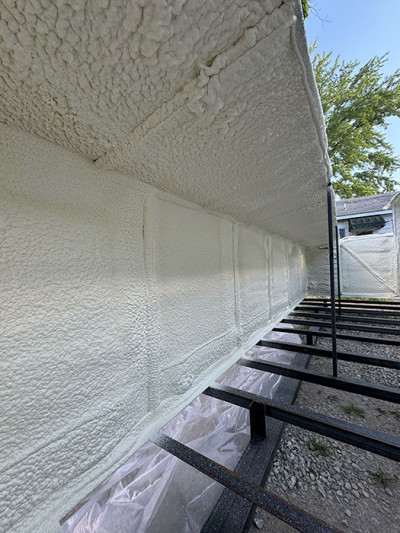Duck & Cover


Spray Foam Magazine – Winter 2024 – Hunting is a sport that trades patience and willpower for delicious bounties and impressive trophies. Dedicated hunters are known to sit outside for hours in cold, exposed conditions just waiting for game to cross their paths. Camouflaged, semi-covered structures like hunting blinds can make these long waits more comfortable and can extend the length of time that hunters spend out in the elements. Adding closed-cell spray polyurethane foam to duck blinds serves to further insulate them, while also doubling as a vapor barrier. Insulated blinds keep hunters outside longer, and the more time outside, the higher the likelihood of getting a lucky shot– or several.
Blake Talley of American Dreams Spray Foam Insulation in Butler, Missouri is on retainer to install SPF to the duck blinds made by Joe Harris of Blind Spot Outdoors in nearby Montrose, Missouri. Harris’s insulated duck blinds have proven popular with customers nationwide, but really hit the target with customers from the North who frequently hunt in wet, freezing climates.
Talley and Harris have a locally grown business relationship; they both live in the same area, and their social circles often intersect. One of their mutual friends owns a restaurant that they both frequent, and it wasn’t long after meeting that Harris began asking Talley questions about how foam could enhance his products– his duck blinds in particular.
“He called me up and asked if foam would add structural strength and make the blinds quieter.” Talley recalls.
Talley was quick to break down all the benefits of adding closed-cell spray foam to Harris’s duck blinds. Not only would the foam somewhat dampen the sound inside the blind while enhancing its structural integrity, the foam layer would also make a noticeable difference in the temperature inside the blinds, and it would work as a moisture barrier. Despite the duck blinds lacking a roof and not being fully enclosed, adding spray foam to the internal walls can still retain warmth when used in conjunction with space heaters, such as the Mr. Heater Buddy Heaters most of the blinds come equipped with. Talley recommended adding two inches of UPC 2.0 closed-cell foam.
“The UPC foam sprays out smooth and it’s very consistent, easy to work with, and nice to look at when it’s finished.” Talley explained.
Looking presentable is a deciding factor in the foams Talley chooses to work with, but the foam’s aesthetics were particularly important for when it came to the duck blinds. The foam wouldn’t be covered up with drywall or anything except paint, so it was critical that it have a smooth and even appearance. After the foam dries, Harris himself typically applies a layer of acrylic or latex exterior paint to the entirety of the blinds, foam and all. No matter the brand, both acrylic and latex-based paints are known to adhere well to spray polyurethane foam, and the brown pigment makes the blind look more uniform and camouflaged. The paint also prevents the foam from naturally discoloring due to constant sunlight exposure.

A finished layer of UPC 2.0 closed-cell spray foam along the duck blind’s interior metal frame.
The first time Talley sprayed a blind for Harris, it was part of an order for a customer in Montana, who planned to use the blind for hunting in snowy weather with temperatures ranging from 10° F to -20° F. The Montana customer loved the insulated blind and it wasn’t long before more customers started inquiring about how to get their own.
Talley and his lead sprayer, John Taylor almost have the process of spraying the duck blinds down to an exact formula. This precision allows them to deliver the same quality of product each time, and also affords them flexibility and efficiency when scheduling these jobs.
“Whenever Joe Harris calls and has something he needs done, we usually squeeze it in between other jobs, either sometime in the early mornings or later on in the afternoons,” Talley explains, adding “It doesn’t take long to do the blinds; maybe an hour and a half.”
The American Dreams team sprays all blinds outside, out on the yard at Blind Spot Outdoors, which means the American Dreams team doesn’t have to put extra effort into ventilating the work area. Even so, they still perform the same level of site preparation as if they were working indoors. They drape a layer of plastic over the blind’s exposed roof to contain overspray while they work inside. Since most blinds at this stage haven’t yet had the floor installed, the team also lays plastic masking on the ground. Likewise, they’ll also cover any other fixtures, such as kitchens or electric lights, and will also note any areas that need a thinner layer of foam to accommodate such fixtures being installed later.
Before spraying, lead sprayer Taylor steps into a pair of SAS’s Moonsuit Nylon and Cotton Hooded Coveralls. He also puts on a 3M full-face respirator and protective gloves. Once the PPE’s on and they’ve been briefed on any special instructions, they begin applying the foam.
The American Dreams team applies two inches across the blind’s metal interior walls using a Carlisle ST1 spray gun. On average, the blinds are about 16 feet long by six and a half feet wide. The foam adheres easily to the clean, metal substrate, since all blinds are sprayed when they’re brand new and haven’t yet been exposed to wear and tear. The foam dries quickly, and later Harris will paint the blinds with an acrylic or latex-based exterior paint.
At the end of every job, the sprayer calls Harris over to do a quality check, happy to perform touch-ups as directed. Once Harris approves, the American Dreams team goes on their way until the next time Talley gets a call about a duck blind in need of spraying. There’s rarely a lot of time in between orders, and with this year’s hunting season soon to be in full swing, the sales forecast continues to look positive for both parties.
Disqus website name not provided.








































